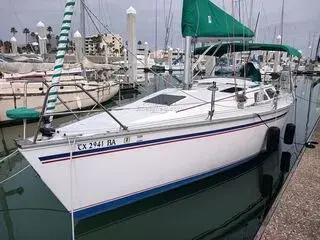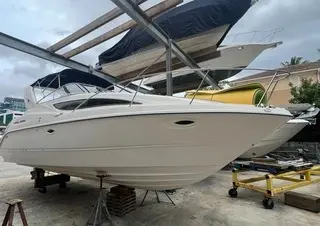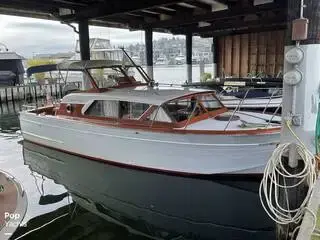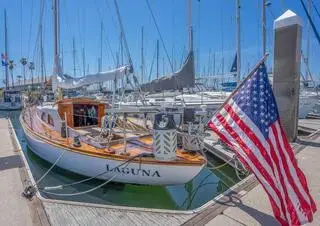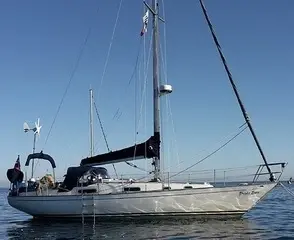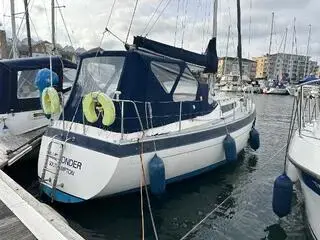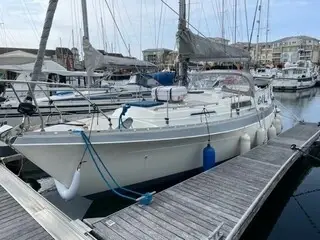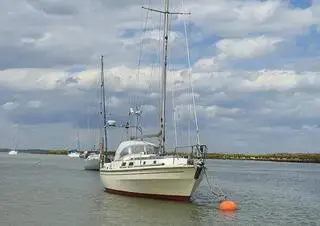Westerly Fulmar£29,950
A twin-keeled example of the popular and well reputed Fulmar, with lines by Ed Dubois, Westerly's build quality and sailing schools' undiminished respect for the design's sailing qualities.
'The current owner of 'Sandyman' has sailed this boat from new, back then as a crew member, then as a joint owner after he had been invited to 'buy in' to her ownership in 1990 and in the last 14 years as her sole owner.
Westerly Fulmar£29,950
A twin-keeled example of the popular and well reputed Fulmar, with lines by Ed Dubois, Westerly's build quality and sailing schools' undiminished respect for the design's sailing qualities.
'The current owner of 'Sandyman' has sailed this boat from new, back then as a crew member, then as a joint owner after he had been invited to 'buy in' to her ownership in 1990 and in the last 14 years as her sole owner. Initially, 'Sandyman' was based on the UK's east coast, from where she cruised Dutch, German and French coasts, before sailing to the Mediterranean and then returned to the UK, to Plymouth, from where she has sailed to Ireland, Wales and the Isles of Scilly as well as France and the Channel Islands.
The owner's intention had been to enjoy his last years of ownership pursuing an ambition to complete an Atlantic circuit in 'Sandyman' and this fact is reflected in the boat's upgraded specification, choice of equipment and level of recent spend on some major items such as a completely new rig (mast, boom, reefing gear, running and standing rig) - just this year (2022); an Aries wind vane self-steering; un-used stays'l and 'lazy' inner for'stay behind the outer for'stay, 215W solar panel on a substantial, stern gantry incorporating the aft pushpits. All this very recent work in addition to previous works including the professional re-bedding and fastening of the keels, replacement of the original engine, replacement of the original sails. Meanwhile the domestic inventory of equipment fitted includes many desirables such an efficient keel-cooled refrigeration; the re-lining of the interior and replacement of the cushions.
Regrettably, after all this work on the boat, the vendor has come to the conclusion that he doesn't have to prove anything to himself any more and that sensibly he should 'hang up the sailing boots' in the knowledge that he's had a 'very good run' with 'Sandyman' over the last 40 years.
We would suggest that 'Sandyman' has clearly been a 'man's boat'; that although the fundamental structures appear to be very good and the systems that are fitted are intended to be reliably simple, the choice of cushion fabric, for example, may not be to the taste of those with more interest in interior decor- the cabin's sole boards have not seen a fresh coat of varnish for a little while; there is no hot water system; nor a heater, but it would not take much time and relatively little money to address these areas and in doing so one could - if one chose to - arrive at a very well-sorted and capable sailboat with an attractively finished interior at a fraction of the cost of doing it all from scratch.
Accommodation:
Head-linings are of foam-backed vinyl down to the hull/deck joint, with needlecord nylon to the hull sides below this level, all completely renewed in 2015. Headroom is approx. 6' 1" at the base of the companionway steps. All berths are 6' 3" long with those in the saloon, straight and parallel to the centreline and provided with lee boards - thereby making excellent sea berths. The cushions (foam and fabric coverings) were replaced approx. five years ago.
The for'cabin offers a conventional double 'V'-berth with stowage beneath and shelves, some 6' in length on both sides. Despite deploying the infill there remains standing room to change clothing abaft the head of the berth, with a dedicated hanging locker, in addition to the more communal locker opposite the heads compartment.
The heads' compartment is forward and to port of the centreline, with the optional additional deck hatch over for greater light and ventilation. A Lavac marine toilet is fitted.
The saloon settees convert to sleeping berths utilising the space beneath the side locker units to increase width right to the side of the hull and the settee backs provide leeboards. The port side settee converts to a double berth for harbour use and there is good daytime stowage of pillows/blankets/duvets behind the backrests in addition to the space beneath and lockers with deep fiddled shelves above. The double-leafed table (with internal bottle storage) is a wonderful feature of the Fulmar's interior; genuinely big enough to accommodate six diners and securely mounted to the hull structure and thereby offering secure support/handhold to crew in a seaway. The cabin windows are of toughened glass, rather than acrylic; so no crazing present.
The Navigation Station is to port and enjoys a dedicated seat rather than relying upon the head of the quarter-berth. The forward-facing chart table, with chart storage under, will accommodate a folded Admiralty chart and is supported by a 3-drawer plinth. There is also a 5' long book shelf above and provision for bulkhead-mounted navigation instruments ahead of the navigation table.
Aft of the Nav. Station there is a very generous quarter-berth that is 3' 10" wide at its head.
Galley: The "L"-shaped galley, to starboard at the base of the companionway, offers a large inset stainless steel sink with foot pumped water supply. There is an electrically refrigerated icebox (with 'keel-cooled compressor) and a gimballed, replacement 'Neptune' gas cooker by Plastimo (approx. 7 years old) featuring a hob with two burners, grill and oven. There is excellent stowage with cut-outs in the aft bulkhead for crockery, a cutlery drawer and a locker under the sink, and an additional locker with three shelves.
Spars And Sail Wardrobe:
Rigged as a 3/4-rigged fractional bermudan sloop, this particular Fulmar's spars were new in May 2022. The original Proctor mast was found to be cracked in some fundamental places and so a new Sparcraft mast and boom, together with a new Facnor roller reefing system was fitted. Opportunity has been taken to have side exits fitted to the mast for the halyards, with clutches on the mast in addition to the original clutches and jammers back at the cockpit and a vertical spinnaker pole stowage system also fitted.
A 'lazy' deployable inner for'stay was fitted, (complete with a ratcheting tensioner) to enable an almost full-hoist stays'l to be set behind the outer for'stay with it's genoa furled. The storm jib would be set on this inner for'stay too.
A rod kicker by Selden is fitted to be able to support the boom conveniently while reefing the mainsail. Three slab reefs are provided for.
In common with all Fulmars, the halyards and reefing lines are led back to the cockpit.
The running rigging was replaced at same time, including a new mainsheet with Harken blocks, coming to the original mainsheet track.
SAILS:
- Fully-battened mainsail by Arun Sails (1995) with three reefs and carried on Rutgerson batten cars.
- Radial cut roller-reefing genoa by Quantum Sails (2004).
- Symmetrical spinnaker by Jeckells.
- Storm Jib
- New, unused hanked stays'l for use on the 'lazy' deployable inner forestay (2022).
- Cruising chute.
Mechanical And Electrical Systems:
Fitted with a replacement to the original Bukh 20, 'Sandyman' is now fitted with a Volvo Penta MD2030-B, rated at approx. 29HP. This was fitted in Feb 1996, together with a high rise exhaust elbow and a Vetus waterlock - in contrast with the original specification for these boats. Subsequently, the propeller shaft has been replaced (2018) and a rope cutter by Ambassador Marine fitted, while the currently fitted engine mounts date from 2020.
An exhaust temperature sensor with a remote indicator (the latter fitted in the cockpit) are fitted for peace of mind.
The engine drives a fixed, two-bladed propeller through a conventional propeller shaft, with a flexibly mounted conventional packing gland to the sterntube.
Electrical Systems
- The 'Domestic and Services Battery' bank comprises of two lead acid batteries of 110 and 115 A/hr capacity.
- A single 100 A/hr battery is fitted for engine cranking.
- The original rotary selection switch is retained so that either battery bank can be used for either function.
- Battery charging is by the engine-driven alternator (to which a Sterling 4-step charge regulator is fitted to maximise the efficiency of the alternator's output), plus a 215W photo-voltaic [Solar] panel regulated by a Victron regulator, with its output monitored by a display facing the chart table.
- A 220-240V AC battery charger is also fitted to support the batteries while the vessel is connected to a shore support supply.
- 12V DC systems are selected and protected by two 8-way high quality circuit breaker panels by 'Blue Sea Systems' to replace the original switch panel supplied by Westerly.
- All navigation lights about the vessel have been fitted with LED lamps, while internally the lights still have filament bulbs.
Sailing Instrumentation & Navigation Equipment:
Within the Cockpit:
- ST60 series multi-display giving speed and depth.
- Contest bulkhead-mounted steering compass.
- Simrad TP30 tiller pilot.
At the chart table:
- Garmin GPSMap 750 colour screen chart plotter, interfaced with;
- Garmin AIS 600 with transponder.
- Handbearing compass.
Deck Equipment:
The cockpit affords seating in comfort for up to six adults and provides tiller steering, single lever engine controls and instrumentation. There is a deep (climb down into!) locker to starboard with a gas canister locker for two bottles immediately ahead. The cockpit seats and coamings have been laid with synthetic 'teak' sheathing, while the original cockpit gratings by Westerly are serviceable and have been retained.
Sail controls are led aft by way of turning blocks to two banks of rope jammers and clutches to winches mounted on the aft end of the coachroof.
Other deck equipment includes:
- 12V DC electric windlass with handheld remote control pad.
- 20kg stainless steel Bruce-style anchor complete with approx. 40m of new chain and warp.
- Harken 40 self-tailing primary sheet winches.
- Barlow 24 and 19 winches for the halyards and reefing lines.
- Acrylic, folding sprayhood carried by a three hoop frame, with grab handle to aft edge.
- Aries wind vane controlled self-steering gear.(BoughtNewin2020andfittedforfirstusein2022-thisunitcostover£3,900alone!)
- Unused drogue, complete with bridle, 80m warp and trip line.
- 5-rung, transom-mounted swim/recovery ladder, with hardwood treads for comfort in use.
- Synthetic 'teak sheathing to the cockpit seating and coamings.
- Minimum 6 inflatable fenders, including 1 'fender step'.
- Minimum 6 mooring ropes.
- Boat hook and 'Easy Moor' mooring aid.
- Outboard engine stowage pad.
Safety Equipment:
- GME 'Accusat' EPIRB.
- Standard Horizon 'Explorer' GMDSS and DSC capable VHF radio.
- SK-200 handheld VHF radio by Plastimo.
- Gillie Firth mast-mounted radar reflector.
- 3 off auto-inflation life jackets (unserviced, or inspected), plus one orally operated lifejacket.
- Jonbuoy auto-inflated danbuoy.
- 2 off horse-shoe lifebuoys.
- Manual bilge pump.
- 12V DC electric bilge pump.
- Pair of bolt croppers.
- Pair of webbing jackstays.
General note on safety equipment: Any safety equipment such as Liferafts, EPIRBS, fire extinguishers and flares etc. are usually personal to the current owner(s) and if being left on-board as part of the sale of a used vessel may require routine servicing, replacement, or changing to meet a new owners specific needs.
